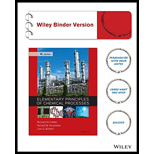
. A gas leak has led to the presence of 1.00 mole% carbon monoxide in a 350-m3laboratory.4 The leak was discovered and sealed, and the laboratory is to be purged with clean air to a point at which the air contains less than the OSHA (Occupational Safety and Health Administration) specified Permissible Exposure Level (PEL) of 35 ppm (molar basis). Assume that the clean air and the air in the laboratory are at the same temperature and pressure and that the laboratory air is perfectly mixed throughout the purging process,
- Let tr(h) be the time required for the specified reduction in the carbon monoxide concentration.
Write a differential CO mole balance, letting A equal the total moles of gas in the room (assume constant), the mole fraction of CO in the room air, and
Integrate the balance to derive an equation for trin terms of
- If the volumetric flow rate is 700 m3/h (representing a turnover of two room volumes per hour), how long will the purge take? What would the volumetric flow rate have to be to cut the purge time in half?
- Give several reasons why it might not be safe to resume work in the laboratory after the calculated purge time has elapsed. What precautionary steps would you advise taking at this point?
Want to see the full answer?
Check out a sample textbook solution
Chapter 10 Solutions
Elementary Principles of Chemical Processes 4e Binder Ready Version + WileyPLUS Registration Card (Wiley Plus Products)
Additional Engineering Textbook Solutions
Process Dynamics and Control, 4e
Elements of Chemical Reaction Engineering (5th Edition) (Prentice Hall International Series in the Physical and Chemical Engineering Sciences)
Computer Systems: A Programmer's Perspective (3rd Edition)
Management Information Systems: Managing The Digital Firm (16th Edition)
Automotive Technology: Principles, Diagnosis, And Service (6th Edition) (halderman Automotive Series)
Introduction to Heat Transfer
 Introduction to Chemical Engineering Thermodynami...Chemical EngineeringISBN:9781259696527Author:J.M. Smith Termodinamica en ingenieria quimica, Hendrick C Van Ness, Michael Abbott, Mark SwihartPublisher:McGraw-Hill Education
Introduction to Chemical Engineering Thermodynami...Chemical EngineeringISBN:9781259696527Author:J.M. Smith Termodinamica en ingenieria quimica, Hendrick C Van Ness, Michael Abbott, Mark SwihartPublisher:McGraw-Hill Education Elementary Principles of Chemical Processes, Bind...Chemical EngineeringISBN:9781118431221Author:Richard M. Felder, Ronald W. Rousseau, Lisa G. BullardPublisher:WILEY
Elementary Principles of Chemical Processes, Bind...Chemical EngineeringISBN:9781118431221Author:Richard M. Felder, Ronald W. Rousseau, Lisa G. BullardPublisher:WILEY Elements of Chemical Reaction Engineering (5th Ed...Chemical EngineeringISBN:9780133887518Author:H. Scott FoglerPublisher:Prentice Hall
Elements of Chemical Reaction Engineering (5th Ed...Chemical EngineeringISBN:9780133887518Author:H. Scott FoglerPublisher:Prentice Hall
 Industrial Plastics: Theory and ApplicationsChemical EngineeringISBN:9781285061238Author:Lokensgard, ErikPublisher:Delmar Cengage Learning
Industrial Plastics: Theory and ApplicationsChemical EngineeringISBN:9781285061238Author:Lokensgard, ErikPublisher:Delmar Cengage Learning Unit Operations of Chemical EngineeringChemical EngineeringISBN:9780072848236Author:Warren McCabe, Julian C. Smith, Peter HarriottPublisher:McGraw-Hill Companies, The
Unit Operations of Chemical EngineeringChemical EngineeringISBN:9780072848236Author:Warren McCabe, Julian C. Smith, Peter HarriottPublisher:McGraw-Hill Companies, The





